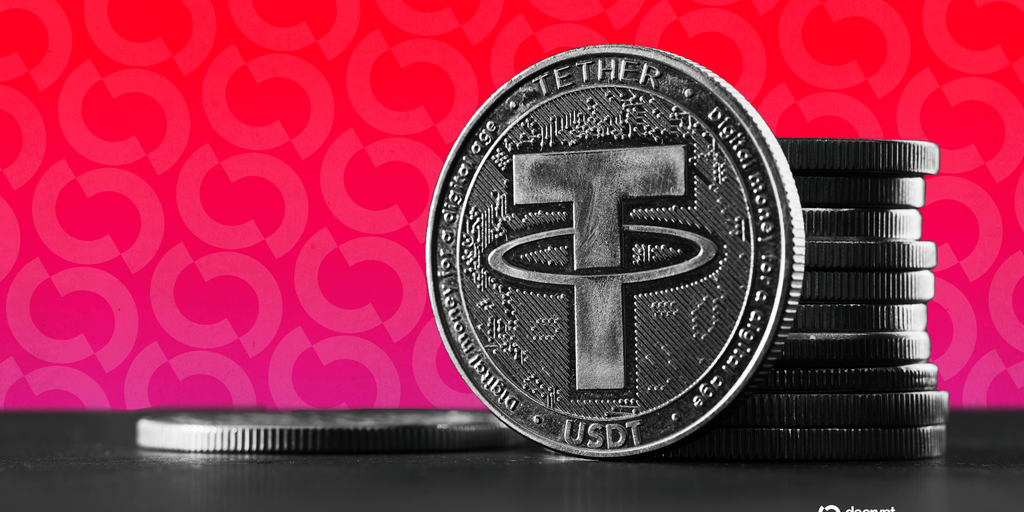In short
- S&P Global Ratings has downgraded USDT’s ability to maintain a 1:1 peg to the dollar, giving it a ‘weak’ rating.
- The credit rating provider said this is because Tether, the company behind USDT, uses risky assets in its reserves to back the token.
- Tether overturned the rating, pointing to how the token has weathered financial market shocks in the past.
S&P Global Ratings has warned stablecoin issuer Tether USDT could lose its 1:1 peg to the US dollar due to some of the assets the digital token is backed by, namely the recently declining Bitcoin.
Credit rating agency S&P Global said On Wednesday, USDT could become “collateralized” if the assets backing the leading stablecoin fall in value. S&P downgraded the coin’s ability to remain at a stable value, giving it a ‘weak’ rating.
S&P Global added that Tether does not provide sufficiently clear information about its custodians, counterparties or bank account providers.
“A decline in the value of Bitcoin, combined with a decline in the value of other risky assets, could therefore reduce reserve coverage and lead to USDT becoming undercollateralized,” the report said.
“A large portion of USDT’s reserves remain invested in short-term U.S. Treasury bonds and other U.S. dollar cash equivalents,” the report said. “However, Tether continues to provide limited information about the creditworthiness of its custodians, counterparties or bank account providers.”
It added: “We observed other weaknesses, including limited transparency on reserves management and risk appetite, lack of a robust regulatory framework, no segregation of assets to protect against issuer insolvency and limits on the primary redeemability of USDT.”
USDT is the most traded digital currency in the crypto world and the third largest digital asset by market capitalization. According to CoinGecko, $76.9 billion worth of USDT tokens have been traded on exchanges around the world in the last 24 hours.
Issued by the El Salvador-based company Tether, the stable currency is mainly used by traders to enter and exit crypto transactions without using traditional banks.
USDT is sold as a digital dollar because, according to Tether, reserves of dollars, government bonds and other assets back the token so it maintains a stable value against the dollar. Stablecoins are widely considered the backbone of the crypto economy.
Regulators have opened investigations into – and even indicted–Tether for allegedly not being transparent enough about what backs its reserves. The company has previously said that it is open to an independent audit by one of the Big Four accounting firms.
Tether said in a statement Wednesday that it “strongly disagrees” with S&P Global’s rating.
“USDT has been in business for over a decade and has consistently maintained full resilience due to banking crises, exchange rate failures, liquidity shocks and extreme market volatility,” the statement said.
“Throughout its history, Tether has never denied a redemption request from a verified user,” it added.
The company’s CEO, Paolo Ardoino, wrote on X on Wednesday that Tether was not upset about the rating.
“We wear your disgust with pride,” he said. “The classic rating models built for legacy financial institutions have historically led private and institutional investors to invest their assets in companies that collapsed despite receiving investment-grade ratings, prompting regulators worldwide to question such models and the independence and objective assessment of all major rating agencies.”
This is what a Tether spokesperson said Declutter that USDT adoption increased as more people found use cases for the token.
Stablecoins have lost their peg to the dollar in the past. By 2023, USDCthe fourth most traded cryptocurrency by market capitalization, decreased in value to 87 cents per token after the company behind the token, Circle, announced it had cash reserves to back its assets at Silicon Valley Bank, which to block by financial regulators in California after a bank run.
And in 2022 crypto project Terra inflated after its algorithmic UST stablecoin failed to maintain its stable peg, creating a $40 billion black hole in the crypto industry – and resulting in a number of bankruptcies in space.
Daily debriefing Newsletter
Start every day with today’s top news stories, plus original articles, a podcast, videos and more.



